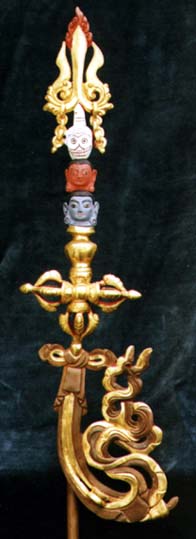
Khatvangha
the khatvangha of Ngak’chang Rinpoche & Khandro Déchen
This khatvangha is of the type which usually ornaments large statues; but, as ‘actual’ khatvanghas are extraordinarily rare, Ngak’chang Rinpoche and Khandro Déchen use this khatvangha when they are in teaching environments and require the presence of this implement.
When it is held by a female manifestation it represents the inner pawo. When it is held by a male manifestation it represents the inner khandro. Every ordained Lama of the gö-kar-çang-lo’i dé (gos dKar lCang lo’i sDe) is obliged to possess, at least in the form of a drawing, the entire assemblage of Vajrayana weaponry. One of the main emblems of the Vajra Master is the khatvangha – the Tantric trident. This implement is a staff which comes in many forms. The simplest kind is a walking stick which is often carried by gÇodpas and gÇodmas – and often used as the central pole of the gÇod tent.
The type of khatvangha represented in this photograph is generally held in the crook of the left arm of statues of Padmasambhava and Yeshé Tsogyel. It is also held by yidams such as Seng-gé Dongma, Seng-gé Dradog, Ögyen Dzambhala and lineage Lamas such as A-Kyong Düd’dül Dorje and Jomo Menmo. Because of its size, this khatvangha is largely representational inasmuch as the silks, bell, and damaru have been cast together as a flat section of gilded copper. The skull, rotten head, and freshly-severed head below the tines of the trident are painted in the colours of the three syllables: Om, A’a:, and Hung (top to bottom – white, red, and blue respectively). These three heads represent: skull (Dharmakaya / chö-ku – chos sKu); rotten head (Sambhogakaya / long-ku – longs sKu); and freshly-severed head (Nirmanakaya / trul-ku – sPrul sKu).
Ngak’chang Rinpoche says of this symbolism:
These three heads, with their associated meanings, are known as ‘the
Tantric joke’. Usually we think of the three kayas in exalted terms – but here
they are depicted in what might be thought of in ordinary societal terms as a
gross manner. Nirmanakaya is a freshly-severed head … we do not even begin
with a living form … we are already dead. This means that there is no hope
for duality, and that the hope gets increasingly less. This is the vital,
lively, and ironic humour of Vajrayana.
